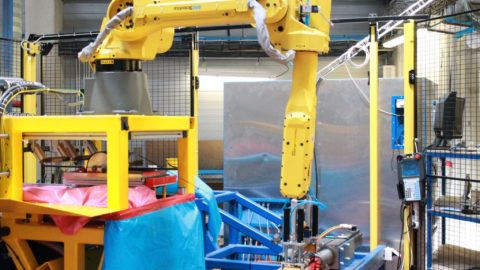
CompoTech's RAFL-powered robot
Composite materials are usually made of a thermosetting resin such as epoxy, reinforced with a fiber component. The type of fiber commonly used by CompoTech is glass fiber, although carbon fiber is more efficient. After the fiber and plastic components are heat cured, it produces a material with a high ratio of strength to the strength.
Fiberglass, drawn from spinning glass (woven glass), has a diameter of a few tens of micrometres small. Then these fibers will lose the disadvantages of solid glass, such as: brittle, easy to break, and become more mechanical. The composition of woven glass may contain additional minerals such as silicon, aluminum, magnesium, etc, to create different types of glass fibers such as: E glass fiber (good electrical conductivity), type C (durability chemical), type R and type S (high mechanical strength), etc.
CompoTech has developed its own yarn crimping technique, called the axon layout method. Cylindrical parts can be formed a using the filament winding technique. This technique improves bending resistance by winding the fibers along the cylinder instead of around its circumference. Here, fibers are continuous chains, impregnated with resin, meander at an angle around a cylinder, then vulcanized. This process can make the material about 10-15% higher than usual. For flexural strength, the figure can be up to more than 50%.
On the other hand, CompoTech is also developing a new milling equipment with components that combine steel and composite materials. This device is fabricated by placing carbon fibers and graphite on a portion of steel using a process called robot-assisted filament laying (RAFL). The steel body acts as a mandrel, while simultaneously connecting the tool with the tool holder and the tool holder to the spindle. It also provides a way to attach the tool to the milling tooth. Composite materials can also be used to fabricate engine spindles. These are usually hybrid structures, with steel used in the bearing and circuit surfaces.
A study by Professor Atsushi Matsubara, Kyoto University has shown that the steel-composite axis is 70% lighter than the steel version with the same design. At the same time, test results show 75% lower shaft displacement when the temperature reaches 70 ° C. Composite spindle vibration resistance 16 times better than the steel version, the maximum rotation speed is also 17% faster due to lower inertia.
Productivity and Quality Office